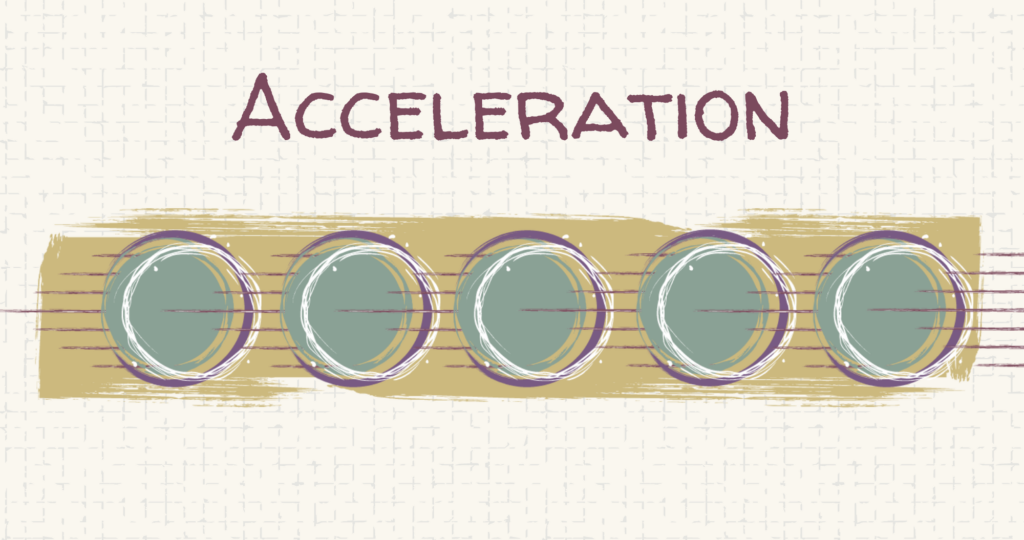How to accelerate your team
How do you access the collective wisdom of the Body Center of Intelligence to move your team forward? Every team, if they want to become high-performing, needs to accelerate, moving as a collective whole.
Accelerating teams move forward together in a common direction because they are aligned and with passion and energy because they are attuned. They know what they are doing and why. If one team member becomes ill or over-burdened, the others not only show concern, they also step up to make sure all the work is done. No one has to ask them to do this. They just want to. Accelerating teams also know instinctively when they have accomplished what they set out to do, when they have not, and what to do in order to move forward.
Teams have specific acceleration challenges at each of the four stages of team development: forming, storming, norming and performing and performing.
Forming acceleration (action) challenges
Can we focus our actions on understanding our charter, tasks, roles and ways of operating, plus getting to know one another as people and the resources we each bring, rather than on moving so quickly to activities and deliverables?
Storming acceleration (action) challenges
Can we slow down our need to take action quickly to get beyond conflict before it’s resolved because we don’t know how, don’t feel uncomfortable addressing issues where we disagree, or don’t trust our gut instincts about what really are the key areas of conflict?
Norming acceleration (action) challenges
Can we use our guts as well as our minds and hearts to create practical and doable new ways of functioning together that we all agree to?
Performing acceleration (action) challenges
Can we modulate our acceleration pace so we remain in conscious choice about what actions we take and how we take them?
To accelerate your team effectively, the team needs to address each of these challenges as the team reaches each consecutive stage of team development. Otherwise, the unresolved issues will either keep them from progressing to the next stage or the team may never even reach the next stage.
But what does the Enneagram have to do with team acceleration? How can the Enneagram help teams accelerate most effectively?
Use the Centers of Intelligence
Help the team understand the 3 Centers of Intelligence and have them explore if they, as a team, are using their collective Body Center in service of the team. Hopefully, the team is aligned and attuned, but are they accelerating together in the right direction at a pace and rhythm that works well for the team and the team’s services, products and/or deliverables?
Depending on the team’s stage of development – forming, storming, norming or performing – teams will have different acceleration issues and opportunities. Have the team discuss these acceleration challenges and then reach collective understandings so they can continue to move forward better together.
The Body Center is especially important regarding team acceleration for two reasons. First, it is the Body Center that is most energized when taking action. But taking action too soon or too early can impede a team’s progress, not help it. Second, the Body Center is also, in a sense, the Truth Center. The body doesn’t lie, although it can become distorted and want to take action even if it is not necessarily the best action or it is action taken too soon or too late. Use the Body center as the team’s Truth Center, guiding the team toward the best action to take, when and how.
What does Enneagram type have to do with this?
Almost everyone, no matter their Enneagram type, likes team action, as long as the action helps achieve the team’s charter and makes a difference. That said, people of each type need to pay attention to certain areas that may not create optimal team acceleration.
Ones
Like pragmatic action that is done right; sometimes pragmatic action may restrict action that may not seem practical at first glance but allows for greater potentiality and possibility.
Twos
Like action that serves the needs and desires of others, particularly customers, but is the customer always right about what is best for them and what is possible to do?
Threes
Like action, especially more immediate action, because action is the way to get results; however, sometimes more deliberative or slower action produces a greater result.
Fours
Like action that generates something meaningful and sustainable, but some action may be small and seemingly without significance yet contributes to the greatest positive outcome.
Fives
Like action that is deliberate and well- thought through; however, some action needs to be more immediate, emergent and spontaneous.
Sixes
Like action that solves problems and addresses issues; that said, some issues dissolve without any action and some action solves no particular problem but makes an enormous positive impact.
Sevens
Like action, but like ideas even more; are you willing and able to take the best ideas into action?
Eights
Like action, but big action and not the small stuff; however, the smaller items may also be really important.
Nines
Like action and like inaction: which to do and when? That is the question!
This blog series is based on Ginger’s forthcoming book, Transform Your Team with the Enneagram: Build Trust, Decrease Stress, and Increase Productivity.
Ginger Lapid-Bogda PhD, author of eight Enneagram books, is a speaker, consultant, trainer, and coach. She provides certification programs and training tools for business professionals around the world who want to bring the Enneagram into organizations with high-impact business applications. TheEnneagramInBusiness.com |ginger@theenneagraminbusiness.com


Comments are closed.